Quantifying China’s Food Self-Sufficiency and Security Transition Based on Flow and Consumption Analyses
Abstract
1. Introduction
1.1. Background
1.2. Literature Review
2. Methods and Data
2.1. Study Area and Data Sources
2.2. Calculation Methods
2.2.1. Food Self-Sufficiency Rate
2.2.2. Stint Counting Method for Estimating Food Demand
2.2.3. Flow Statistics Method for Estimating Food Demand
2.2.4. Consumption Statistics Method for Estimating Food Demand
2.2.5. Flow–Consumption Statistics Method for Estimating Food Demand
3. Results
3.1. National-Scale Food Security Status
3.1.1. Comparison of Self-Sufficiency Rates Using Traditional Methods
3.1.2. Self-Sufficiency Rates Using the FCS Method
3.2. Provincial-Scale Food Security Status
3.3. Spatiotemporal Analysis of Food Security
3.3.1. Spatiotemporal Dynamics of Food Self-Sufficiency Rate
3.3.2. Spatiotemporal Dynamics of Grain Self-Sufficiency Rate
4. Discussion
4.1. Urban–Rural Disparities and Their Impact on Food Security
4.2. Spatial Inequality in Food Security
4.3. Policy Recommendations
4.4. Limitations and Future Research
5. Conclusions
Author Contributions
Funding
Institutional Review Board Statement
Informed Consent Statement
Data Availability Statement
Acknowledgments
Conflicts of Interest
Appendix A
| Data Type | Specific Categories | Temporal/Spatial Scale | Source |
|---|---|---|---|
| Food production | Food, grain, rice, wheat, maize, legumes, and tubers | 2010–2022, national and provincial | China Statistical Yearbook (2010–2022) |
| Population | Urban population and rural population | 2010–2022, national and provincial | China Statistical Yearbook (2010–2022) |
| Food trade and stock | Wheat, rice, maize, and soybean | 2010–2022, national | FAO Statistical Database (https://www.fao.org/faostat/en/#home, accessed on 20 May 2025) |
| Food consumption | Food, grain, non-cereal grains, tubers, and legumes | 2010–2022, national and provincial | China Statistical Yearbook, Provincial Statistical Yearbooks (2010–2022) |
| Meat and animal products | Total meat, pork, beef, mutton, other meats, poultry, aquatic products, eggs, and dairy | 2010–2022, national and provincial | China Statistical Yearbook, Provincial Statistical Yearbooks (2010–2022) |
| Food for industrial use | Liquor, beer, ethanol, starch, and MSG | 2010–2022, national and provincial | China Light Industry Yearbook (2010–2022) |
| Sown area | Food, grain, rice, wheat, maize, legumes, and tubers | 2010–2022, national and provincial | China Statistical Yearbook (2010–2022) |
| Livestock and Poultry | Wheat | Corn | Soybeans | Rice | Potato |
|---|---|---|---|---|---|
| Beef | 8 | 69 | 8 | 8 | 7 |
| Mutton | 13 | 60 | 13 | 7 | 7 |
| Pork | 10 | 65 | 10 | 5 | 10 |
| Dairy products | 8 | 62 | 15 | 8 | 7 |
| Poultry | 10 | 60 | 10 | 10 | 10 |
| Industrial Use | Liquor | Beer | Ethanol | Starch | MSG |
|---|---|---|---|---|---|
| Conversion Factor | 2.3 | 0.17 | 3 | 1.6 | 5 |
| Food Type | Rice | Wheat | Corn | Tubers | Soybeans |
|---|---|---|---|---|---|
| Share (%) | 14.04 | 15.23 | 45.79 | 7.4 | 14.4 |
References
- McCarthy, U.; Uysal, I.; Badia-Melis, R.; Mercier, S.; O’Donnell, C.; Ktenioudaki, A. Global food security–Issues, challenges and technological solutions. Trends Food Sci. Technol. 2018, 77, 11–20. [Google Scholar] [CrossRef]
- Basset, C. Soil security: The cornerstone of national security in an era of global disruptions. Soil Secur. 2024, 16, 100154. [Google Scholar] [CrossRef]
- SDG Fund. Sustainable Development Goals. Available online: https://www.un.org/sustainabledevelopment/inequality (accessed on 8 May 2025).
- Food and Agriculture Organization of the United Nations (FAO). The State of Food Security and Nutrition in the World (SOFI) Report 2023; FAO: Rome, Italy, 2023. [Google Scholar]
- Krishnamurthy, R.P.K.; Fisher, J.B.; Choularton, R.J.; Kareiva, P.M. Anticipating drought-related food security changes. Nat. Sustain. 2022, 5, 956–964. [Google Scholar] [CrossRef]
- Reed, C.; Anderson, W.; Kruczkiewicz, A.; Nakamura, J.; Gallo, D.; Seager, R.; McDermid, S.S. The impact of flooding on food security across Africa. Proc. Natl. Acad. Sci. USA 2022, 119, e2119399119. [Google Scholar] [CrossRef]
- Molotoks, A.; Smith, P.; Dawson, T.P. Impacts of land use, population, and climate change on global food security. Food Energy Secur. 2021, 10, e261. [Google Scholar] [CrossRef]
- Abbas, S.; Haider, A.; Kousar, S.; Lu, H.; Lu, S.; Liu, F.; Li, H.; Miao, C.; Feng, W.; Ahamad, M.I.; et al. Climate variability, population growth, and globalization impacting food security in Pakistan. Sci. Rep. 2025, 15, 4225. [Google Scholar] [CrossRef]
- Ben Hassen, T.; El Bilali, H. Impacts of the Russia-Ukraine war on global food security: Towards more sustainable and resilient food systems? Foods 2022, 11, 2301. [Google Scholar] [CrossRef]
- Alabi, M.O.; Ngwenyama, O. Food security and disruptions of the global food supply chains during COVID-19: Building smarter food supply chains for post COVID-19 era. Br. Food J. 2023, 125, 167–185. [Google Scholar] [CrossRef]
- Xi, J. Hold High the Great Banner of Socialism with Chinese Characteristics and Strive in Unity for Building a Modern Socialist Country in All Respects: Report to the 20th National Congress of the Communist Party of China; Foreign Languages Press: Beijing, China, 2023. [Google Scholar]
- Lee, C.C.; Zeng, M.; Luo, K. The impact of urbanization on food security in China. Int. Rev. Econ. Financ. 2024, 93, 1159–1175. [Google Scholar] [CrossRef]
- Liu, Y.; Zhou, Y. Reflections on China’s food security and land use policy under rapid urbanization. Land Use Policy 2021, 109, 105699. [Google Scholar] [CrossRef]
- Zhu, Y.; Wang, Z.; Zhu, X. New reflections on food security and land use strategies based on the evolution of Chinese dietary patterns. Land Use Policy 2023, 126, 106520. [Google Scholar] [CrossRef]
- Li, S.; Kallas, Z.; Rahmani, D. Did the COVID-19 lockdown affect consumers’ sustainable behaviour in food purchasing and consumption in China? Food Control 2022, 132, 108352. [Google Scholar] [CrossRef] [PubMed]
- He, G.; Zhao, Y.; Wang, L.; Jiang, S.; Zhu, Y. China’s food security challenge: Effects of food habit changes on requirements for arable land and water. J. Clean. Prod. 2019, 229, 739–750. [Google Scholar] [CrossRef]
- Zhu, X.; Zhang, Y.; Zhu, Y.; Li, Y.; Cui, J.; Yu, B. Multidimensional deconstruction and workable solutions for addressing China’s food security issues: From the perspective of sustainable diets. Land Use Policy 2025, 148, 107401. [Google Scholar] [CrossRef]
- Liang, X.; Jin, X.; Han, B.; Sun, R.; Xu, W.; Li, H.; He, J.; Li, J. China’s food security situation and key questions in the new era: A perspective of farmland protection. J. Geogr. Sci. 2022, 32, 1001–1019. [Google Scholar] [CrossRef]
- Lan, Y.; Xu, B.; Huan, Y.; Guo, J.; Liu, X.; Han, J.; Li, K. Food security and land use under sustainable development goals: Insights from food supply to demand side and limited arable land in China. Foods 2023, 12, 4168. [Google Scholar] [CrossRef]
- Kang, M.; Wang, Y.; Zhu, Y.; He, F.; Jiang, S.; Yang, M. Optimizing the structure of food production in China to improve the sustainability of water resources. Sci. Total Environ. 2023, 900, 165750. [Google Scholar] [CrossRef]
- Wu, F.; Geng, Y.; Zhang, Y.; Ji, C.; Chen, Y.; Sun, L.; Xie, W.; Ali, T.; Fujita, T. Assessing sustainability of soybean supply in China: Evidence from provincial production and trade data. J. Clean. Prod. 2020, 244, 119006. [Google Scholar] [CrossRef]
- Wang, M.; Liu, D.; Wang, Z.; Li, Y. Structural evolution of global soybean trade network and the implications to China. Foods 2023, 12, 1550. [Google Scholar] [CrossRef]
- Lu, G.; Miao, Y.; Dong, X.; Dong, Z.; An, H.; Li, X. Strategies for improving food security under the impact of external grain price fluctuations: Evidence from China. Appl. Econ. 2025, 57, 887–903. [Google Scholar] [CrossRef]
- Cole, M.B.; Augustin, M.A.; Robertson, M.J.; Manners, J.M. The Science of Food Security. npj Sci. Food 2018, 2, 14. [Google Scholar] [CrossRef] [PubMed]
- He, T.; Hu, Y.; Li, F.; Chen, Y.; Zhang, M.; Zheng, Q.; Jin, Y.; Ren, H. Mapping Land- and Offshore-Based Wind Turbines in China in 2023 with Sentinel-2 Satellite Data. Renew. Sustain. Energy Rev. 2025, 214, 115566. [Google Scholar] [CrossRef]
- Chang, H.; Zhao, Y.; Cao, Y.; He, G.; Wang, Q.; Liu, R.; Li, W. Evaluating Sustainability of Water–Energy–Food–Ecosystems Nexus in Water-Scarce Regions via Coupled Simulation Model. Agriculture 2025, 15, 1271. [Google Scholar] [CrossRef]
- Chung, M.G.; Liu, J. International food trade benefits biodiversity and food security in low-income countries. Nat. Food 2022, 3, 349–355. [Google Scholar] [CrossRef]
- Liang, X.; Jin, X.; Xu, X.; Chen, H.; Liu, J.; Yang, X.; Xu, W.; Sun, R.; Han, B.; Zhou, Y. Uncertainty in China’s food self-sufficiency: A dynamic system assessment. Sustain. Prod. Consum. 2023, 40, 135–146. [Google Scholar] [CrossRef]
- Beltran-Peña, A.; Rosa, L.; D’Odorico, P. Global food self-sufficiency in the 21st century under sustainable intensification of agriculture. Environ. Res. Lett. 2020, 15, 095004. [Google Scholar] [CrossRef]
- Zhang, Z.; Kattel, G.R.; Shang, Y.; Wang, G.; Chuai, X.; Wang, Q.; Cui, X.; Miao, L. Steady decline in food self-sufficiency in Africa from 1961 to 2018. Reg. Environ. Change 2023, 23, 79. [Google Scholar] [CrossRef]
- Zhang, J.; Fang, Y.; Zheng, H.; Fan, S.; Du, T. The spatio-temporal evolution of food production and self-sufficiency in China from 1978 to 2020: From the perspective of calories. Foods 2023, 12, 956. [Google Scholar] [CrossRef]
- Niu, Y.; Xie, G.; Xiao, Y.; Liu, J.; Wang, Y.; Luo, Q.; Zou, H.; Gan, S.; Qin, K.; Huang, M. Spatiotemporal patterns and determinants of grain self-sufficiency in China. Foods 2021, 10, 747. [Google Scholar] [CrossRef]
- Zhang, Y.; Lu, X. A comprehensive evaluation of food security in China and its obstacle factors. Int. J. Environ. Res. Public Health 2022, 20, 451. [Google Scholar] [CrossRef]
- Liu, Y.; Zhen, L.; Shao, Q.; Ye, J.; Xie, S. Spatiotemporal Patterns in Production and Consumption of Major Foods in Qinghai, China. Foods 2025, 14, 736. [Google Scholar] [CrossRef] [PubMed]
- Xiao, Y.; Zhao, J.; Zhang, Y.; Wang, S. Grain Self-Sufficiency in Guangdong, China: Current Trends and Future Perspectives. Foods 2025, 14, 1126. [Google Scholar] [CrossRef] [PubMed]
- Duan, X.; Meng, Q.; Fei, X.; Lin, M.; Xiao, R. The impacts of farmland loss on regional food self-sufficiency in Yangtze River delta urban agglomeration over last two decades. Remote Sens. 2021, 13, 3514. [Google Scholar] [CrossRef]
- Herteux, J.; Raeth, C.; Martini, G.; Kraemer, M.; Brunner, A.; Gunkel, L.; Bartke, J. Forecasting Trends in Food Security with Real-Time Data. Commun. Earth Environ. 2024, 5, 611. [Google Scholar] [CrossRef]
- Niu, Y.; Xie, G.; Xiao, Y.; Liu, J.; Zou, H.; Qin, K.; Wang, Y.; Huang, M. The Story of Grain Self-Sufficiency: China’s Food Security and Food for Thought. Food Energy Secur. 2022, 11, e344. [Google Scholar] [CrossRef]
- Xiao, Y.; Cheng, S.; Xie, G.; Liu, A.; Lu, C.; Wang, Y. The Balance between Supply and Consumption of the Main Types of Grain in China. J. Nat. Resour. 2017, 32, 927–936. (In Chinese) [Google Scholar]
- Xu, Y.; Zhao, Y. The Situation of Food Self-Supply and Development Countermeasures in Sichuan Province. J. Agric. 2021, 11, 97. (In Chinese) [Google Scholar]
- Meng, Z.D.; Li, G.X. The Spatio-Temporal Evolution of China’s Grain Production and Demand Balance: From the Perspectives of Grain Use and Provincial Level. Res. Agric. Mod. 2020, 41, 928–936. (In Chinese) [Google Scholar]
- Yang, M.; Pei, Y.; Li, X. Study on Grain Self-Sufficiency Rate in China: An Analysis of Grain, Cereal Grain and Edible Grain. J. Nat. Resour. 2019, 34, 881–889. (In Chinese) [Google Scholar] [CrossRef]
- World Wide Fund For Nature. Report on Food Waste in Chinese Cities; World Wide Fund For Nature: Beijing, China, 2018. [Google Scholar]
- Wang, L.E.; Ni, X.W.; Li, Y.Y. Measurement of the scale of food waste and its resources and environmental effects at the consumer segment in China. J. Nat. Resour. 2021, 36, 1455–1468. [Google Scholar] [CrossRef]
- The World Bank. Available online: https://www.worldbank.org/ext/en/home (accessed on 8 May 2025).
- The World Bank. Available online: https://data.worldbank.org/ (accessed on 8 May 2025).
- FAO. Available online: https://www.fao.org/worldfoodsituation/csdb (accessed on 8 May 2025).
- FAO. Available online: https://openknowledge.fao.org/items/6c17080e-6c5d-47ae-a982-609c882bd4e7 (accessed on 8 May 2025).
- Gao, Q.J. Forcasting and analysis of grain consumption of urban and rural residents. Chin. Rural Econ. 2004, 10, 20–25. (In Chinese) [Google Scholar]
- Gustavsson, J.; Cederberg, C.; Sonesson, U.; van Otterdijk, R.; Meybeck, A. Global Food Losses and Food Waste: Extent, Causes and Prevention; Food and Agriculture Organization of the United Nations: Rome, Italy, 2011. [Google Scholar]
- Ishangulyyev, R.; Kim, S.; Lee, S.H. Understanding Food Loss and Waste—Why Are We Losing and Wasting Food? Foods 2019, 8, 297. [Google Scholar] [CrossRef] [PubMed]
- Xue, L.; Liu, X.; Lu, S.; Cheng, G.; Hu, Y.; Liu, J.; Liu, G. China’s food loss and waste embodies increasing environmental impacts. Nat. Food 2021, 2, 519–528. [Google Scholar] [CrossRef] [PubMed]
- Gatto, A.; Chepeliev, M. Global food loss and waste estimates show increasing nutritional and environmental pressures. Nat. Food 2024, 5, 136–147. [Google Scholar] [CrossRef]
- Wu, H.; Zhang, Z.; Xu, J.; Song, J.; Han, J.; Zhang, J.; Li, S. Food consumption away from home had divergent impacts on diet nutrition quality across urban and rural China. Food Secur. 2025, 17, 41–56. [Google Scholar] [CrossRef]
- Wang, R.; Lu, S.; Zhou, L.; Yang, Z.; Tang, Z.; Zhao, M.; Cheng, G. Assessing nutritional and economic aspects of food loss and waste in China. Sustain. Prod. Consum. 2023, 42, 95–105. [Google Scholar] [CrossRef]
- Norton, W. The Relevance of von Thünen Theory to Historical and Evolutionary Analysis of Agricultural Land Use. J. Agric. Econ. 1979, 30, 39–47. [Google Scholar] [CrossRef]
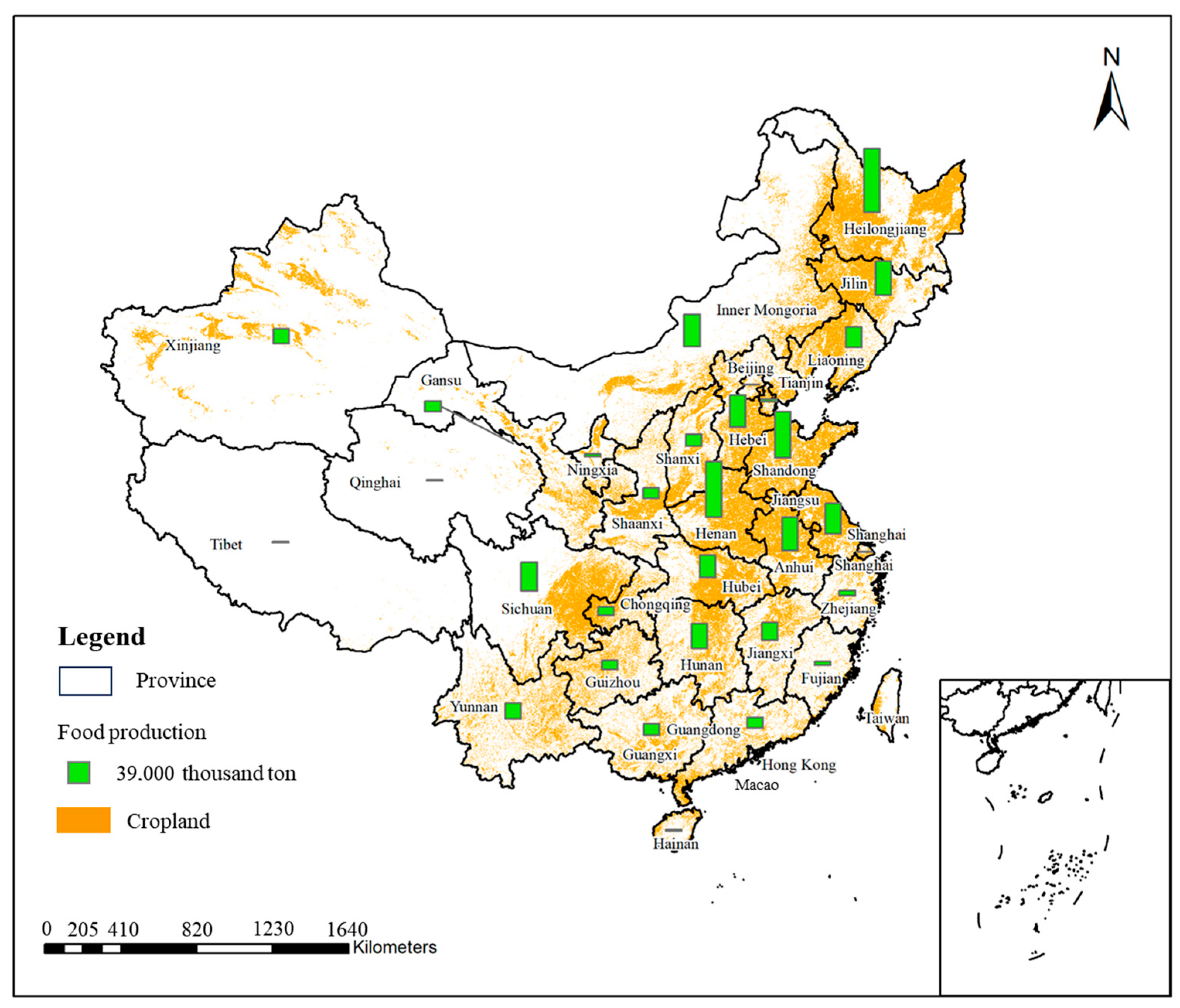
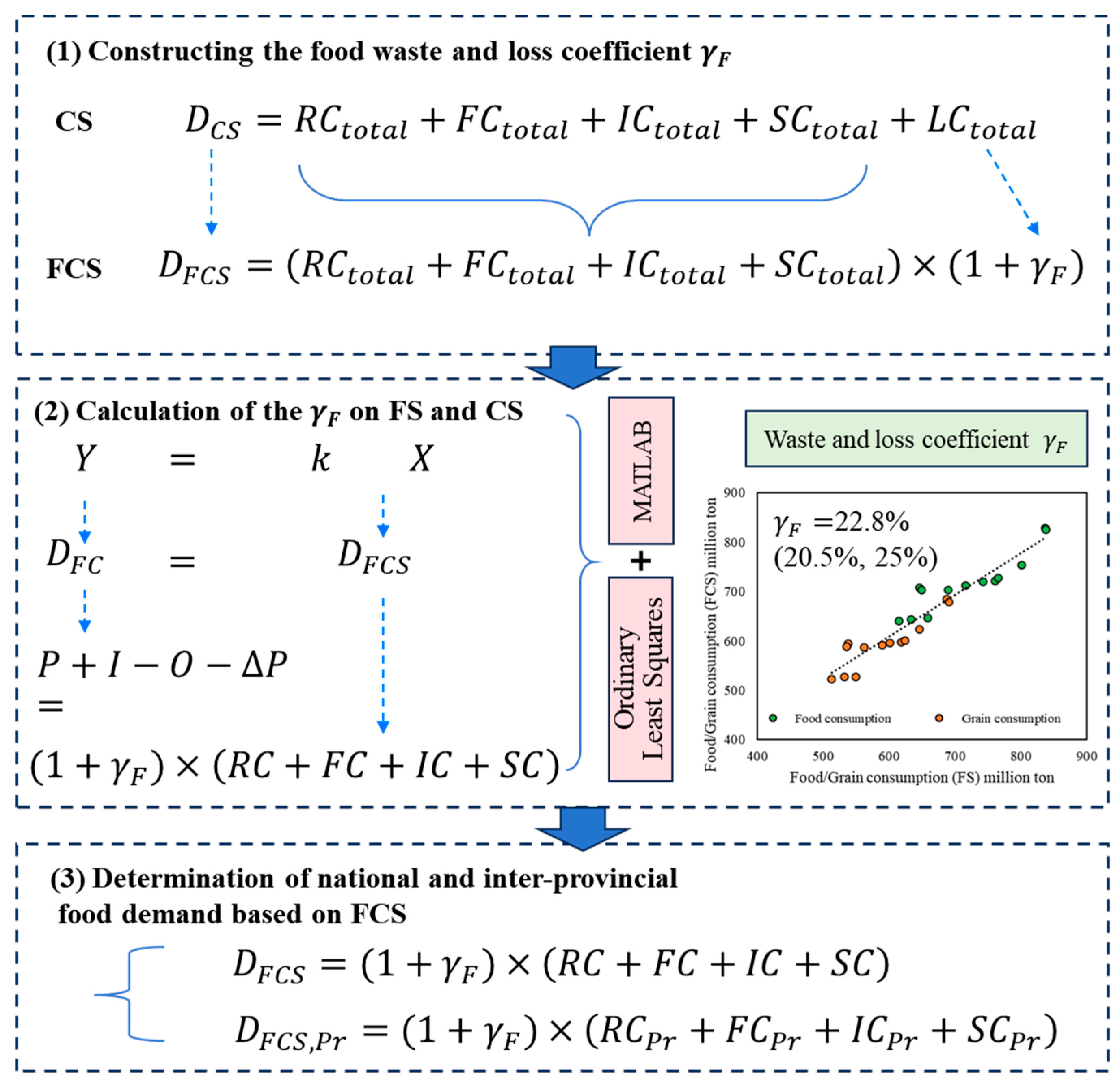



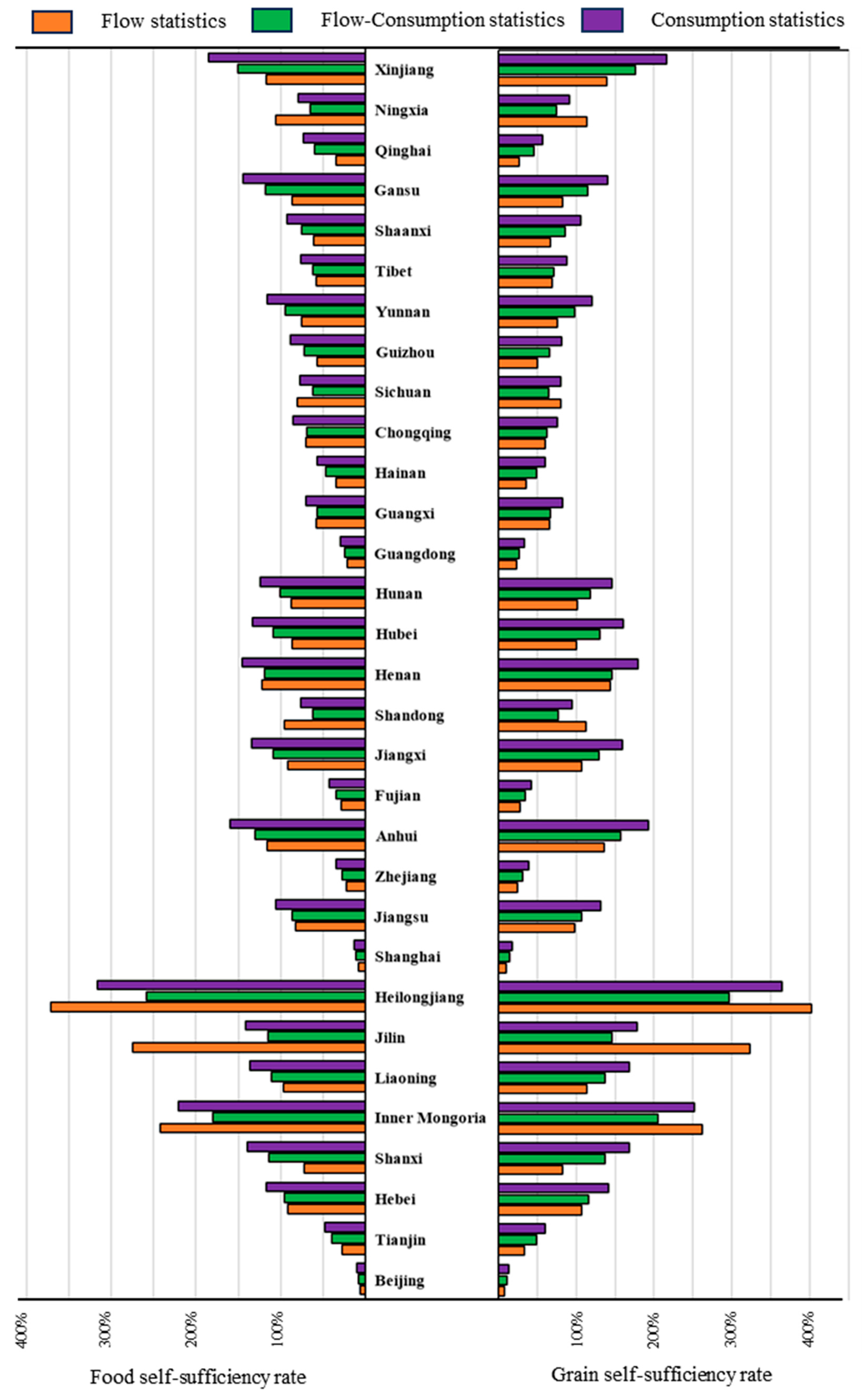
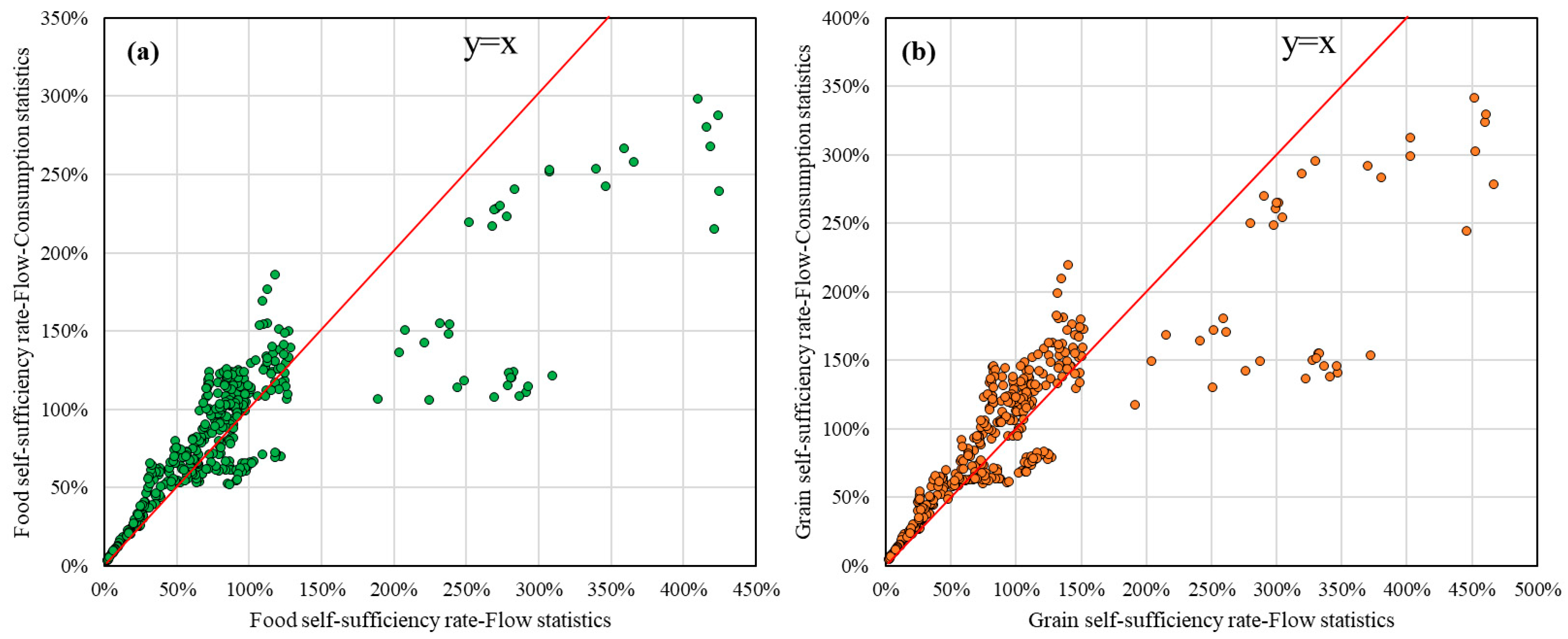
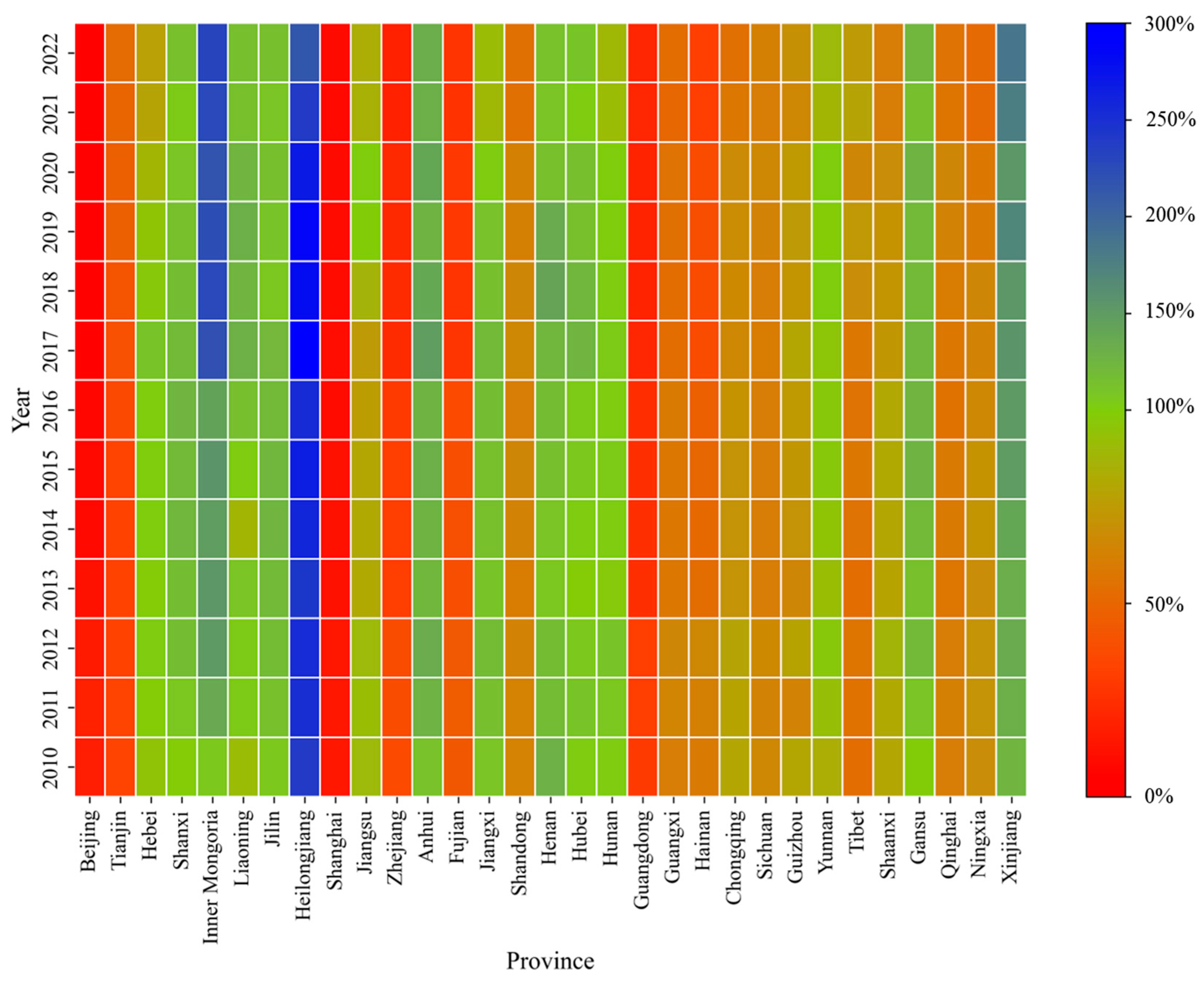
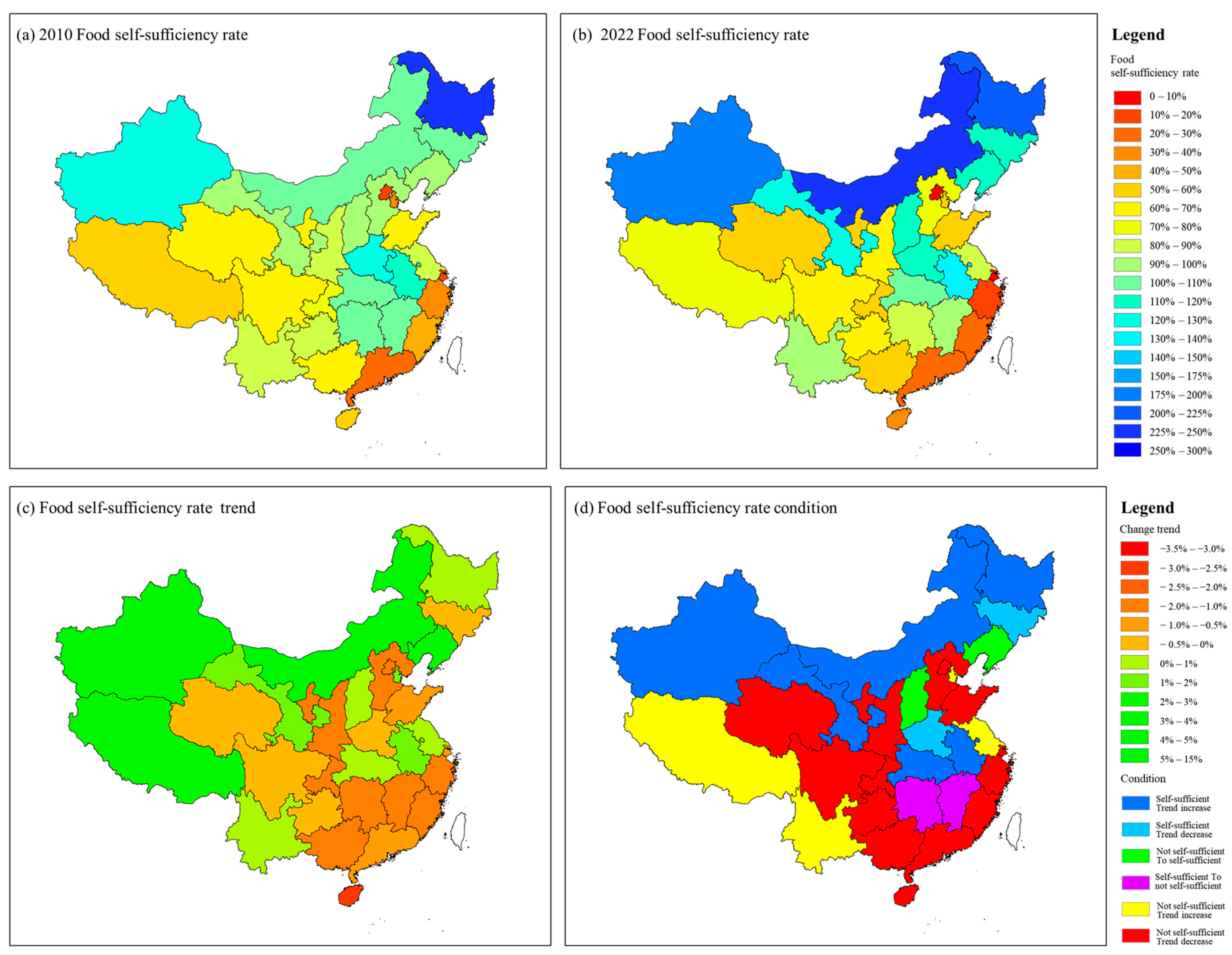
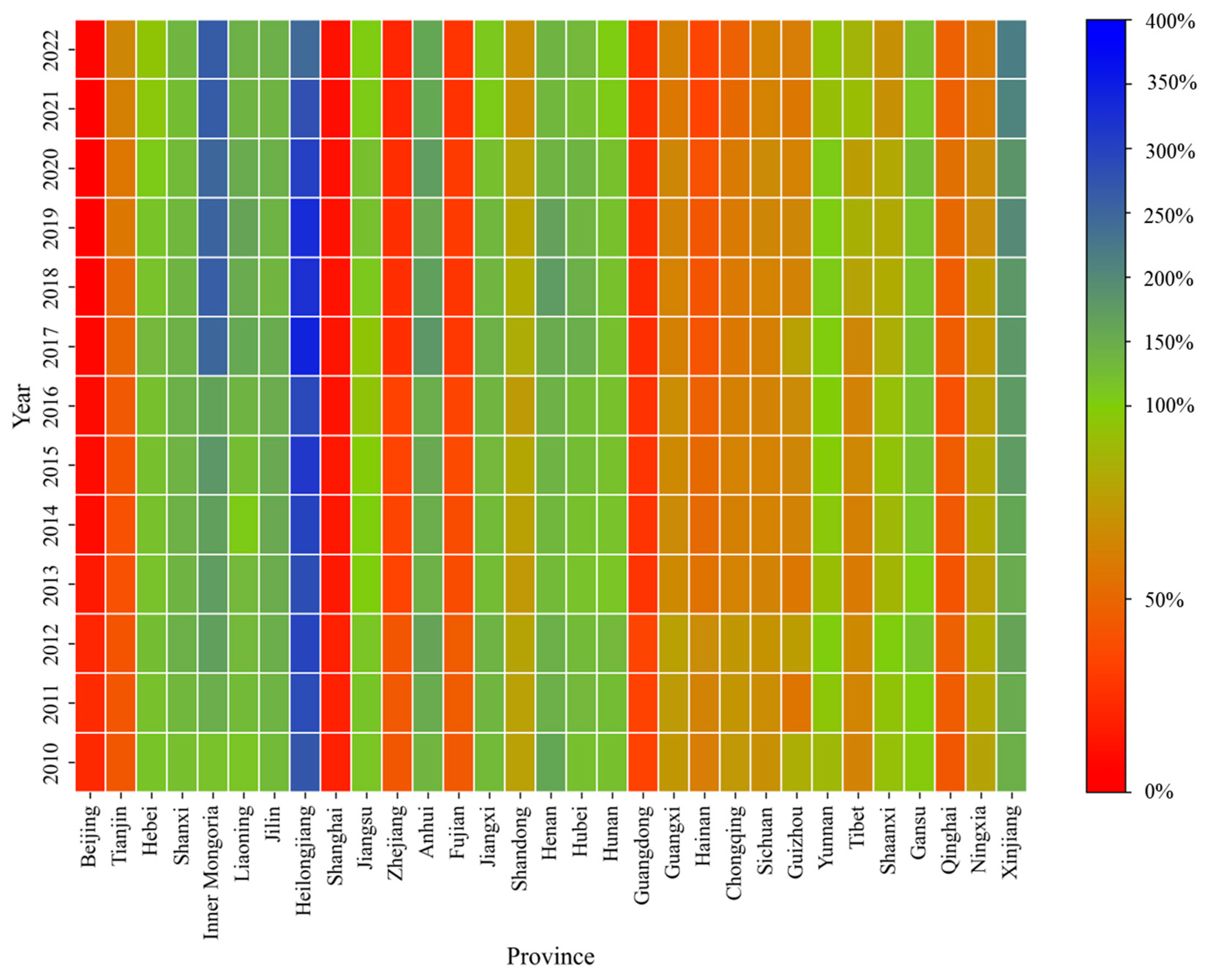
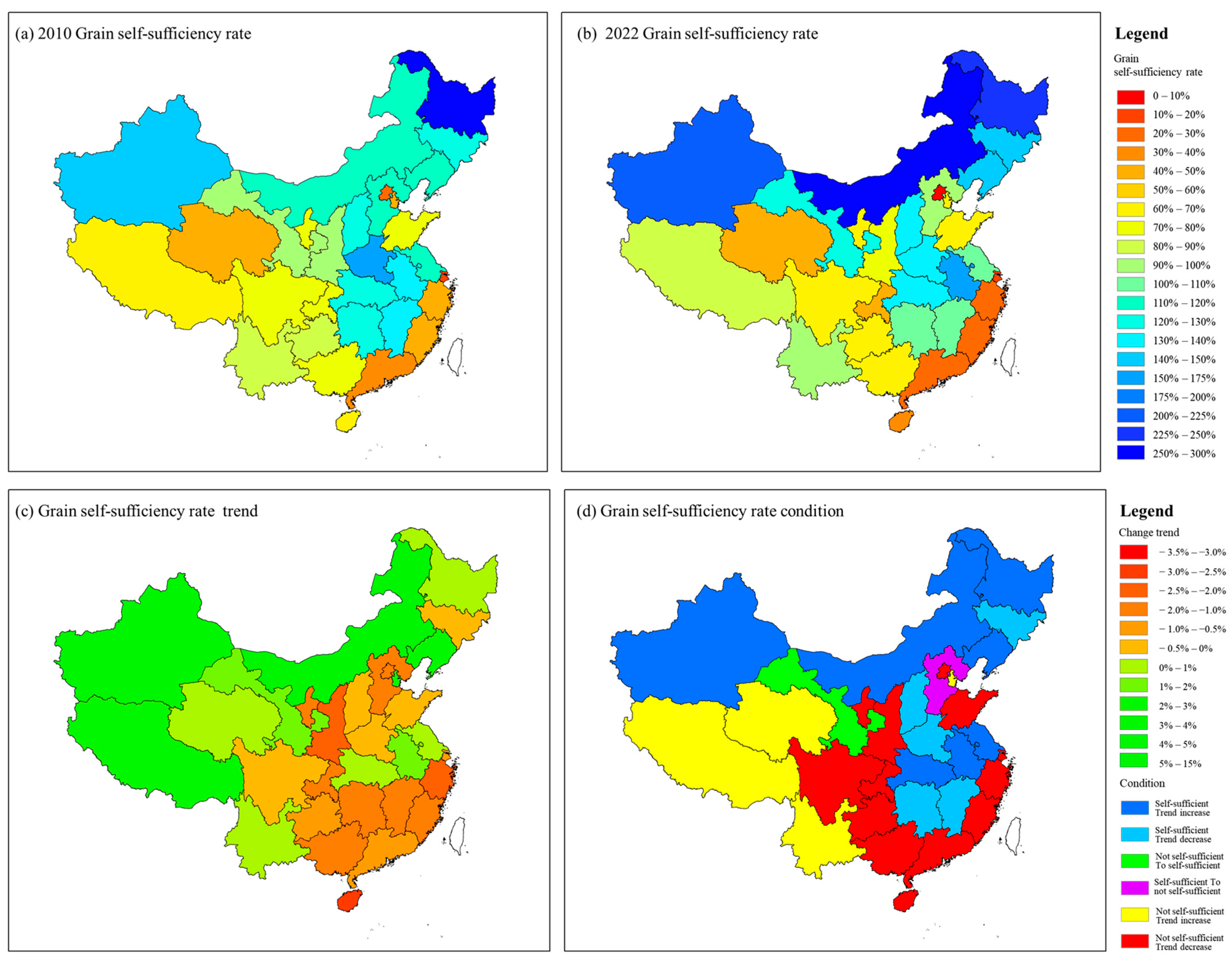

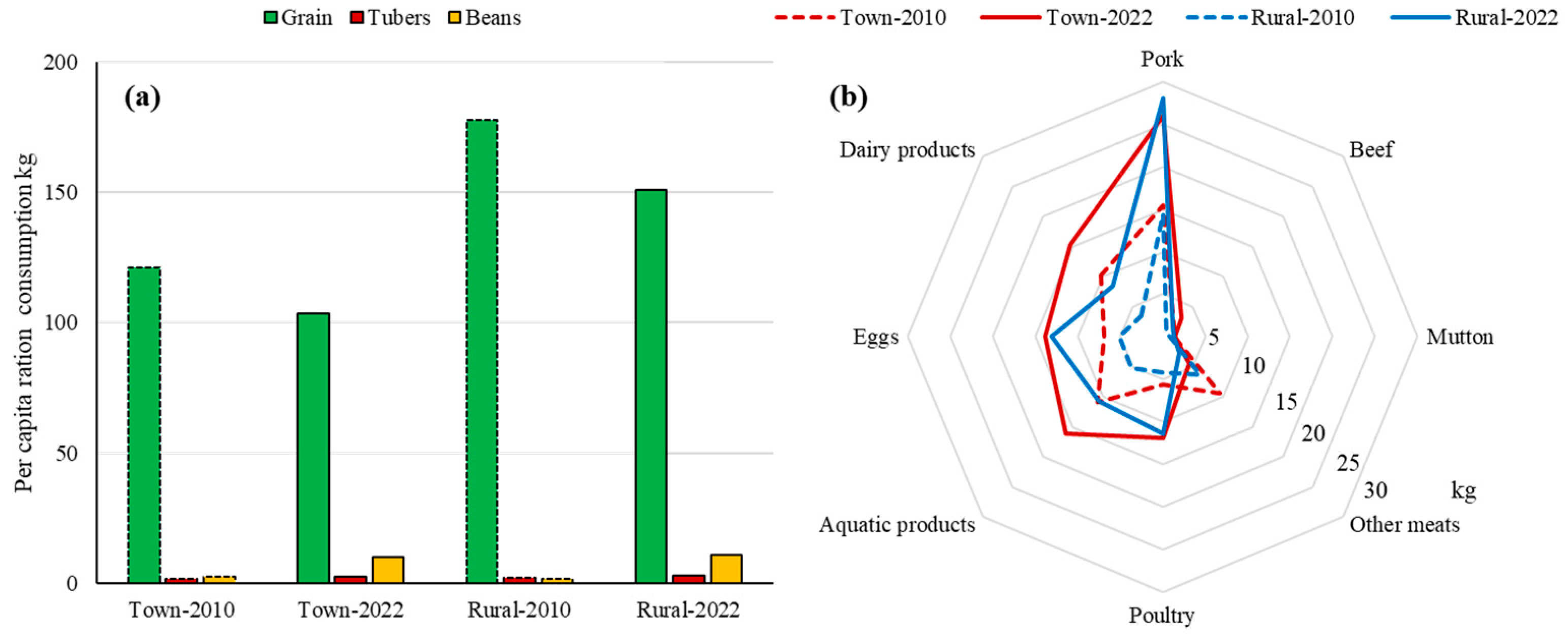

Disclaimer/Publisher’s Note: The statements, opinions and data contained in all publications are solely those of the individual author(s) and contributor(s) and not of MDPI and/or the editor(s). MDPI and/or the editor(s) disclaim responsibility for any injury to people or property resulting from any ideas, methods, instructions or products referred to in the content. |
© 2025 by the authors. Licensee MDPI, Basel, Switzerland. This article is an open access article distributed under the terms and conditions of the Creative Commons Attribution (CC BY) license (https://creativecommons.org/licenses/by/4.0/).
Share and Cite
Chang, H.; Zhao, Y.; Cao, Y.; Liu, R.; Li, W.; Ren, H.; Hong, Z.; Yao, J. Quantifying China’s Food Self-Sufficiency and Security Transition Based on Flow and Consumption Analyses. Sustainability 2025, 17, 5965. https://doi.org/10.3390/su17135965
Chang H, Zhao Y, Cao Y, Liu R, Li W, Ren H, Hong Z, Yao J. Quantifying China’s Food Self-Sufficiency and Security Transition Based on Flow and Consumption Analyses. Sustainability. 2025; 17(13):5965. https://doi.org/10.3390/su17135965
Chicago/Turabian StyleChang, Huanyu, Yong Zhao, Yongqiang Cao, Rong Liu, Wei Li, He Ren, Zhen Hong, and Jiaqi Yao. 2025. "Quantifying China’s Food Self-Sufficiency and Security Transition Based on Flow and Consumption Analyses" Sustainability 17, no. 13: 5965. https://doi.org/10.3390/su17135965
APA StyleChang, H., Zhao, Y., Cao, Y., Liu, R., Li, W., Ren, H., Hong, Z., & Yao, J. (2025). Quantifying China’s Food Self-Sufficiency and Security Transition Based on Flow and Consumption Analyses. Sustainability, 17(13), 5965. https://doi.org/10.3390/su17135965







